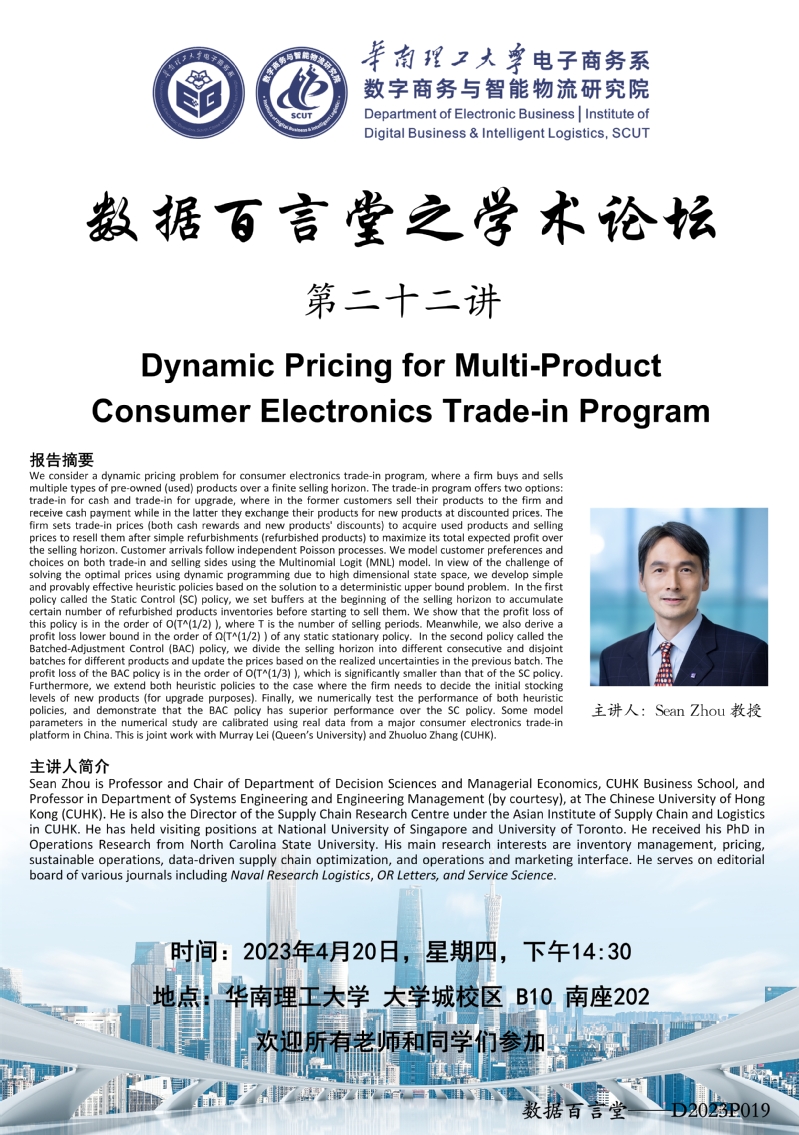
报告题目: Dynamic Pricing for Multi-Product Consumer Electronics Trade-in
Program
主讲人: Sean Zhou
报告时间:2023年4月20日,下午14:30
报告地点:大学城校区B10座南202会议室
欢迎广大师生参加。
报告摘要:We consider a dynamic pricing problem for consumer electronics trade-in program, where a firm buys and sells multiple types of pre-owned (used) products over a finite selling horizon. The trade-in program offers two options: trade-in for cash and trade-in for upgrade, where in the former customers sell their products to the firm and receive cash payment while in the latter they exchange their products for new products at discounted prices. The firm sets trade-in prices (both cash rewards and new products' discounts) to acquire used products and selling prices to resell them after simple refurbishments (refurbished products) to maximize its total expected profit over the selling horizon. Customer arrivals follow independent Poisson processes. We model customer preferences and choices on both trade-in and selling sides using the Multinomial Logit (MNL) model. In view of the challenge of solving the optimal prices using dynamic programming due to high dimensional state space, we develop simple and provably effective heuristic policies based on the solution to a deterministic upper bound problem. In the first policy called the Static Control (SC) policy, we set buffers at the beginning of the selling horizon to accumulate certain number of refurbished products inventories before starting to sell them. We show that the profit loss of this policy is in the order of O(T^(1/2)), where T is the number of selling periods. Meanwhile, we also derive a profit loss lower bound in the order of Ω(T^(1/2) of any static stationary policy. In the second policy called the Batched-Adjustment Control (BAC) policy, we divide the selling horizon into different consecutive and disjoint batches for different products and update the prices based on the realized uncertainties in the previous batch. The profit loss of the BAC policy is in the order of O(T^(1/3), which is significantly smaller than that of the SC policy. Furthermore, we extend both heuristic policies to the case where the firm needs to decide the initial stocking levels of new products (for upgrade purposes). Finally, we numerically test the performance of both heuristic policies, and demonstrate that the BAC policy has superior performance over the SC policy. Some model parameters in the numerical study are calibrated using real data from a major consumer electronics trade-in platform in China. This is joint work with Murray Lei (Queen’s University) and Zhuoluo Zhang (CUHK).
主讲人简介: Sean Zhou is Professor and Chair of Department of Decision Sciences and Managerial Economics, CUHK Business School, and Professor in Department of Systems Engineering and Engineering Management (by courtesy), at The Chinese University of Hong Kong (CUHK). He is also the Director of the Supply Chain Research Centre under the Asian Institute of Supply Chain and Logistics in CUHK. He has held visiting positions at National University of Singapore and University of Toronto. He received his PhD in Operations Research from North Carolina State University. His main research interests are inventory management, pricing, sustainable operations, data-driven supply chain optimization, and operations and marketing interface. He serves on editorial board of various journals including Naval Research Logistics, OR Letters, and Service Science.

